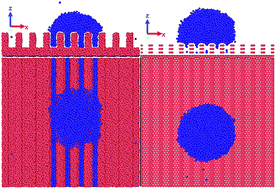The wetting characteristics of aluminum droplets on rough surfaces with molecular dynamics simulations
Abstract
In the present study, the impact of surface roughness on the wettability behavior of Al droplets has been investigated via molecular dynamics (MD) simulations. In this work, amorphous carbon (AC) and graphite substrates with different depths and widths were considered. The results show that the increased width of grooves causes the transition of the wetting state from Cassie to Wenzel. Thermodynamic property analysis results indicate that the solid–liquid adhesion and the work done for the removal of the Al droplet from the solid surface decrease as the roughness increases. However, the adhesion in the Wenzel wetting state is better than that in the Cassie wetting state. Therefore, the contact angle increases with the increased roughness in the Cassie wetting systems, while in the Wenzel wetting systems, the contact angle is less than that in other rough systems. In addition, due to the heterogeneity of the surfaces, the density of Al droplets in the solid–liquid interface is decreased with the increased roughness. The anisotropic spreading of Al liquid can be explained by the MSD curves along the X and Y directions.



 Please wait while we load your content...
Please wait while we load your content...